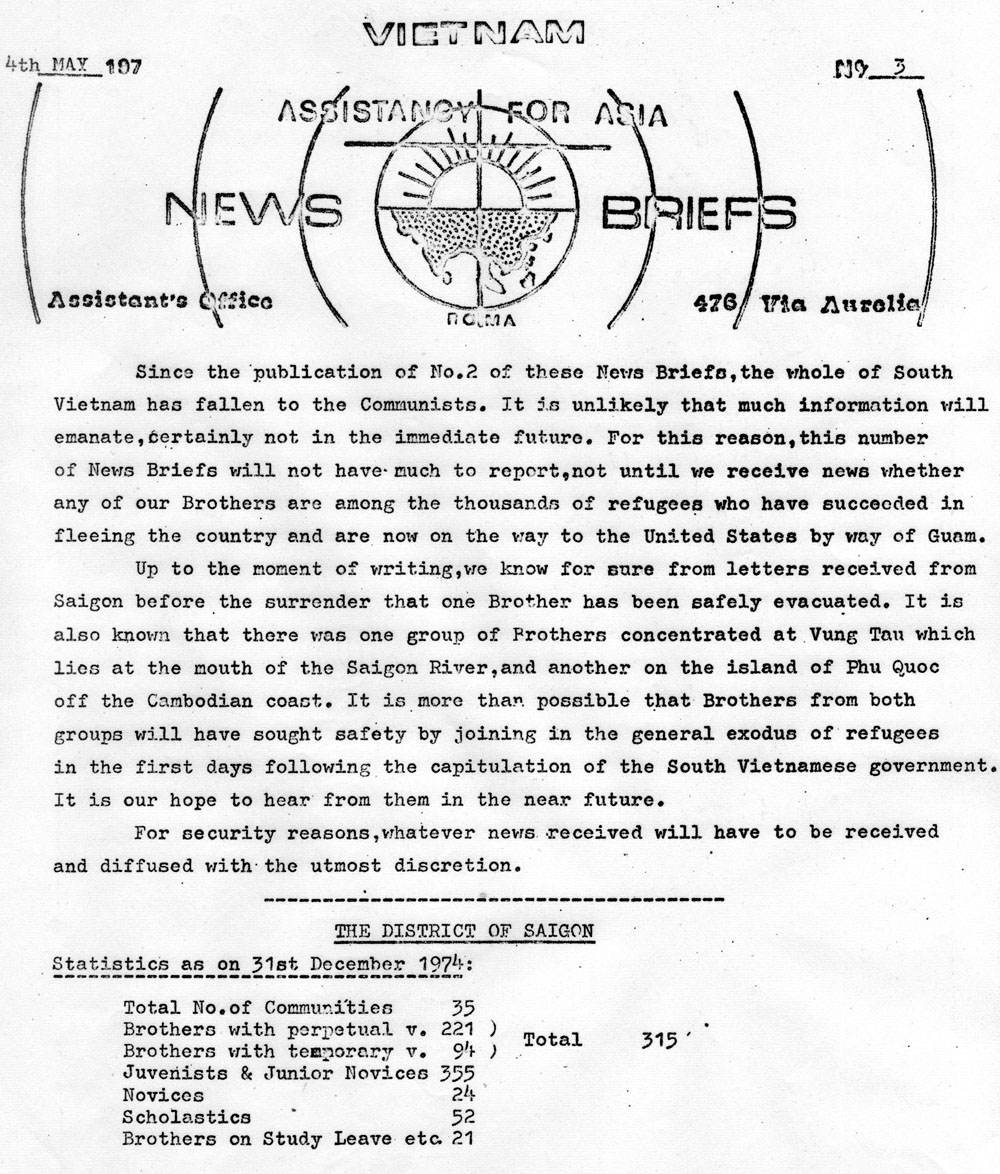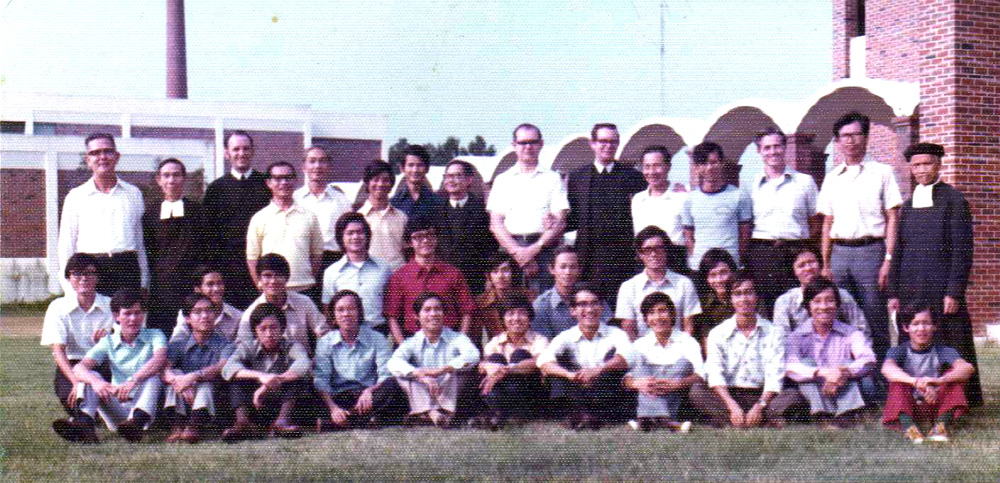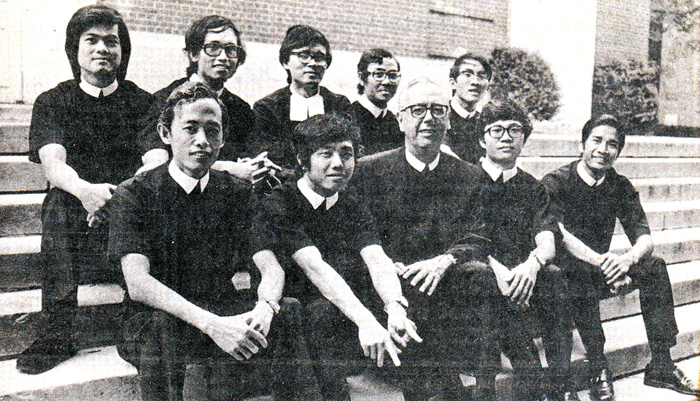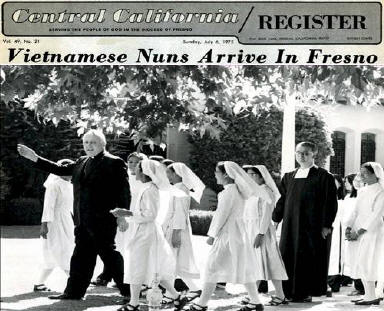
Part 1: Brothers and Sisters successfully escaped from Vietnam South
News Briefs #3 from Roma, May 4,
1975:
"... Since the publication of News Briefs #2, the entire South Vietnam
has been fallen to the communists of North Vietnam.
...
While writing the current #3, we are for sure - through a letter from Saigon
before the capitulation, that a Brother has safely escaped. We are also informed
that a group of Brothers gathered at Vung Tau, and another group in Phu Quoc
Island. It is probable that these two groups of Brothers will be along with
their refugee compatriots seeking for a secure way to escape on the very first
days after the capitulation of the regime of Saigon...
..."

Appendix: For more details published in News Briefs #4-#10.
***
A. The Sub-District of Saigon in Paris
There were some Vietnamese Brothers who had been in France before the events of 1975. Most of them were sent to Paris for their studies and had been there for one, or two or even three years. After April 30, 1975, there was no way for them to return to their homeland. Thus, they had to "adopt" France - willy-nilly - as their new homeland.
In addition, there were a group of Brothers - most of them had been young Brothers at the Scholasticate - and one La Salle Sister accompanying her brother, who willingly chose to be resettled in France after being rescued by American ships on April 30, 1975 and disembarked in Guam a few days later. The Vietnamese Brothers who had been present in Paris before cordially welcomed these newcomer Brothers, and the French Brothers drove them to a community in Angers, the capital of the historic province of Anjou and considered one of the most beautiful cities in France.
At the Chapter General 1976 in Rome, Brother Jose Pablo replaced Brother John Johnston as Superior General. With the approval of the Central Counsel, Brother Superior General created the new Sub-District of Saigon in Paris. Such a sub-district was to gather all Vietnamese Brothers in Europe and if possible the Vietnamese Brothers who had been resettled in other countries. Brother Barthélémy (Paul Lê Cừ) was assigned Auxiliary Visitor of the Sub-District of Saigon in Paris. At the beginning, the sub-district was composed of more than 30 Vietnamese Brothers in the region of Paris.
|
|
|
|
A new community had been created at Rue Raymond Bertout in Drancy, a city of the Department of Saint Dennis. Brother Paul Lê Cừ, Auxiliary Visitor and director of the community, invited all Vietnamese Brothers to join. Only two Brothers, Léonce Cường and Arthème Chung, came to the new community. They had been in Paris for their studies two years before. Other student Brothers of their group like Abel Quang, Gabriel Khải, Gauthier Kỳ, etc. had disappeared nobody knows when.
Younger Brothers in Angers tried to adopt the new life-style and culture. But so much perturbed by both socio-political and psychological circumstances just a few weeks before, it seemed that such an adaptation had to be rather difficult and unsuccessful. Even their leader, Brother Mutien Ngoc, who had been studying in Paris for more than 3 years by the end of the 60’s, gave up and quit the Congregation. To remedy such a development, Brother Paul Lê Cừ, Auxiliary Visitor, called up Brother Herman from Australia and invited him to take care of younger Brothers. Brother Herman, Director of the community, had done his best to re-vitalize the community life but it didn’t last long. A few months later, all left the congregation, except Brother Herman himself and Brothers Dominique An and Joseph Phương [Brother Joseph Pham’s family that had been resettled in the United States, sponsored him according to the ODP program into the USA. He then quit the Congregation. In 1990, Joseph Pham petitioned to re-enter the Congregation and the District of San Francisco accepted. He lived with the Vietnamese Brothers at La Salle Vietnam House.] The Vietnamese community in Angers had thus disappeared.
With approval and support from Brother Superior General José Pablo and from many Vietnamese Brothers present in Paris as well, Brother Paul Lê Cừ had been looking for appropriate location where the members of the sub-district of Saigon in Paris would gather together for their education mission. The bishop of Noumea in New Caledonia offered a good location in Thio, the Collège Francis Rougé (equivalent to an elementary and middle school.) Brothers Christophe Hạnh, Yacinthe, Antoine Long and Dominique An volunteered to join him to form a new community in Thio. In addition, Brother Girard Nhơn from Australia volunteered to augment the number of community members.
Obeying to the "order" of Brother superior general José Pablo that "all the Brothers who have successfully fled overseas from Vietnam should go to New Caledonia", Brother Désiré from Nha Trang went himself to the new community. Brother Paul discussed with the community on splitting into two communities: One in Thio, running the Collège Francis Rougé, and another, trying to recruit new vocations in Nouméa.
In France, another Vietnamese community had been opened in Ivry by the La Salle Fondation on the request of those Vietnamese Brothers who had come to Paris, like Brothers Pierre Nghiêm, Adrien Hoá, Félicien Nghiêm, Roger Vĩnh, Noel Pinot, Alexandre Ánh, Bosco Bắc, and Victor Bửu, etc... The community in Ivry that was named ALDER (Association Lasallienne D’Entraide des Réfugiés) at 4 bis, rue des Frères Blais, 94200, Ivry sur Seine, composed of Brother Pierre, founder and chairman - Brothers Adrien, Herman and Victor, to run different activities for Vietnamese refugees in general (e.g. festivities of Christmas Season, Lunar New Year, etc.) and for tutoring in French, Math and Sciences for Vietnamese high school students in particular.
| On the First Day of Lunar New
Year of 1986, Brother Pablo, Superior General came to visit the
community at Drancy, France. Members of the Sub-District present
in Paris at the times were more or less anxious for the
continued or stop existing of the Sub-District. They discussed
and talked among themselves that "although our apostolic
works in New Caledonia would be unsuccessful for lacking of
personnel or because no-one wants to go over there. But the
existence of the Sub-District is still very important and
necessary because it's the only means adequate for us to
maintain relationship, support, and share with our Brothers in
Vietnam everything we can on hands..." After the personal meeting with each Brother, Brother Pablo didn't mention about the works and personnel in New Caledonia. He just recalled certain moments he was in Vietnam for the 100th Year of Taberd's Foundation in 1974, visiting certain communities, etc... He expressed his comprehensive and compassionate sentiments for the lost of "every things" since April 30, 1975 not only for the Brothers of the District of Saigon but also for Vietnamese people... He commanded a more brotherly motivation "among yourselves and your Vietnamese people as well". He encouraged and supported the program of ALDER for the service of education and enculturation to the new life-style in France of those who encountered similar situations in their life. |
|
***
B. The Vietnamese Brothers integrated into different Districts of the United States.
On May 16, 1975, the Vietnamese Brothers with 21 La Salle Sisters (Postulants and Novices included) who wished to be resettled in the United States of America were driven to the Refugee Center, Fort Chaffee, Arkansas.
Brother Visitor of the District of Illinois, John Johnston, and some Brothers from New York, Pennsylvania, San Francisco, etc... came to Fort Chaffee to welcome all of them.
Brother Assistant in charge of the Asia Region, Michael Jacques, immediately fled to Arkansas to welcome them, too.

from left to right
3rd line: Michael Jacques -
Gonzague Bí - John Johnston - Raphael Đỉnh - Francis Trí - Jean Lộ -
Pascal Triều - Théophane Kế
Brother Visitor (?) - Leo Kirby - Bonnard Bá - Fortunat Phong -
Colman Coogan - Ignace Châu - Jean Ngoạn
middle line: Martin Phước - Cyrille Hiến - Tiên - Antoine Lộc -
Trung Sơn - Thiện - Thierry Tín - J.B. Thư - Thomas Mỹ - Michael Quang
front line: Joseph Ninh - Thomas Hiến - Trung - Antoine Trụ -
Joseph Hiệp - Raphael Đông - F.X. Ban - Hùng - Francis Nhàn - Antoine
Long - Minh
American Brothers thought that "it's not good to gather all Vietnamese refugee Brothers into the same location, for it would be like assembling them into a ghetto." Brother Michael Jacques didn't think so. "It's rather better to assemble the Vietnamese refugee Brothers into the same location, he argued, so that, thanks to their same language, same culture and tradition, they can much comfortably adapt to the new life-style, and thus they can progressively develop their apostolic works as they have done in their homeland before the events of 1975."
Meetings and debates and discussions followed. But, how many Vietnamese Brothers can understand English?
Each American Brother Visitor seems to convince Vietnamese Brothers: "Come! You're most welcomed to my District...!" To tell the truth, the "brand" names of some cities or states - like New York, Philadelphia, Chicago, San Francisco, Los Angeles... that the Vietnamese Brothers had heard or seen on some labels of food and/or goods, are more attractive to them than the eloquence of American Brothers.
* Most of Vietnamese refuguee Brothers
decided to join the District of New York;
* A Brother with his family join the District of Baltimore
* An other Brother with his family join the District of Illinois
* Two or three Brothers join the District of San Francisco
* An other Brother join the District of New-Orleans Santa-Fe
 A group of Vietnamese refugee Brothers in New York |
 After being resettled in New York, the first duty is to learn English |
Like their confreres who had been resettled in France after the April 30, 1975, the Vietnamese refugee Brothers resettled in the United States of America had to confront with so many difficulties to adapt a the new life - psychologically, culturally, even morally and socially speaking. A few months trying their best, most of them were content to quit their vocations...
***
C. The Brothers integrated into the District of Australia.
Although all the Brothers from Vung Tau and/or from Phu Quoc Island and Rach Gia, had been on wooden boat ready to flee overseas at the same times, but amidst tumultuous chaos of sauve qui peut, they were disparate onto different directions on the high seas, and separated from each other onto different countries. There was a case really sad and anxious for the sort of a group of four Brothers who, from the start they had been closely together but arriving to Thai seashore, they found themselves only three. Where the fourth, Brother Constance then Director of the community of Duc Minh, Tan Dinh? The latter Brother is said "lost" and no news from here until now.
The three Brothers were so happy meeting again an other Brother, Herman then Director of the Lasalle Technical School of Dalat, who had been on an other wooden boat from Ba Ria. The four Brothers decided to be resettled in Australia, and the District of Austria was more happy to welcoming them.
A few weeks after the fall of Saigon into the communist hands, the Thai government shows anxiety and doubt over all Vietnamese residing in Bangkok and other cities of Thailand, even those people have been working a long time before 1975 in Thailand. The same sort occurred to Vietnamese Brothers, sort of missionaries in Thailand some for over decades. Thai soldiers entered their community houses, searched for everything they doubt relating to the Marxist ideology, i.e. to communism.
Such ambiance of doubt pushed almost all Vietnamese Brothers to
think of "escaping from Thailand":
1. Brother Victor received the refugee card from the French Consulate and was
resettled in Paris;
2. Brother Cosmas was lucky to change "tourist status" into "refugee status" in
the United States, and was resettled in Philadelphia;
3. Brothers Vial and Nicet were welcomed to the District of Australia.
In 1977, two other Brothers, Girard and Prosper were also happy on their successful fleeing overseas by wooden boat and were welcomed to the District of Australia.
***
D. The La Salle Sisters in the United States
From the refugee camp in Guam, the La Salle Sisters had been transferred to Fort Chaffee. The American La Salle Brothers came to visit them and at their request, presented their case to Bishop of Fresno in California, Hugh A. Donohoe. On June 19, 1975, Bishop welcomed and offered to them the whole property of Ryan Seminary at 1530 N. Fresno Street for their stay, at least temporarily. The delegation of seven American La Salle Brothers, Philip Thez, Michael Walsh, Daniel, John Achin, Clarence Schenk, Christopher Donnelly and Bradley Francis came to welcome the La Salle Sisters at Ryan Seminary. The District of San Francisco assisted and subsidized in providing them with food supplies and everything they needed for their living. Brother Raphael Willeke, Visitor of the San Francisco District, assigned Brother Philip Thez, Director of the La Salle Brothers Community and Principal at San Joaquin Memorial School, as Supervisor to the Sisters. Brother George Kohles took the role of Liaison Brother between the La Salle Brothers and the La Salle Sisters.

After resettled in Fresno, the La Salle Sisters tried to adapt to the new life
in America. But, so many turbulent and painful happenings more than two months
earlier had psychologically and sentimentally affected younger Postulants and
Sisters. Most of them had no news from their families and relatives since the
first day they had to leave Mai Thon for Vung Tau (Cf. Journal 1, pages 43-45.)
The total of Sisters and Postulants were twenty. Nearly two thirds of them were
from 16 to 24 years of age. These young ladies left the Congregation a few
months later.
Five years later, in 1980, Bishop Madera in the diocese of Fresno, , who had
replaced Bishop Hugh A. Donohoe a few months earlier, wanted to take back Ryan
Seminary transforming it into a retreat center for different Groups and
Associations of the diocese. Reverend Nguyen Van Tnh, pastor at a Vietnamese
Mission in San Jose, suggested that the La Salle Sisters move to San Jose and
help him in apostolic works like catechism and certain activities for young
people. He promised to look for a house for them, and assured them of canonical
permission from the diocese of San Francisco. [At that time, the diocese of San
Jose didn’t yet exist.] Thanks to Sister Sheila, a representative for all
Vietnamese Women Congregations in the United States, Sister Theresa Claire
Nguyen had opportunity to meet with Bishop Pierre DuMaine who became the first
bishop of the diocese of San Jose at the moment the diocese of San Francisco had
been split into two dioceses: Arch-diocese of San Francisco and diocese of San
Jose. On August 31, 1980, the La Salle Sisters officially moved to San Jose.
***
For more details : Journal 2: Threshold of New Hope